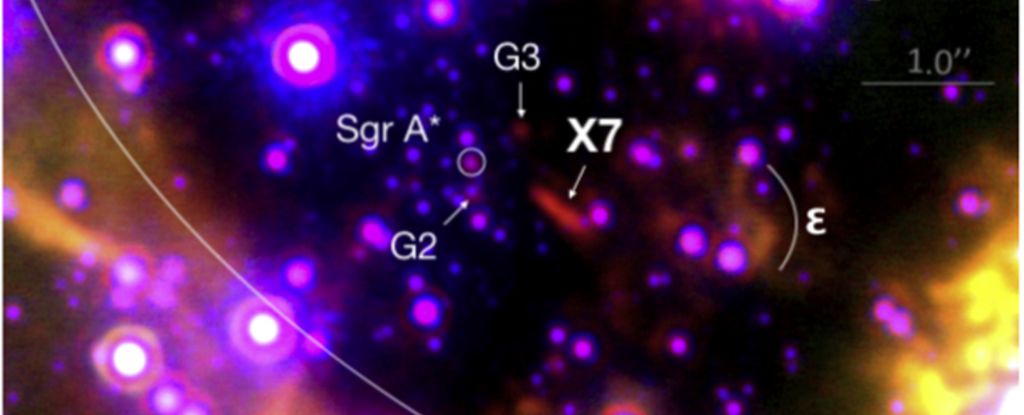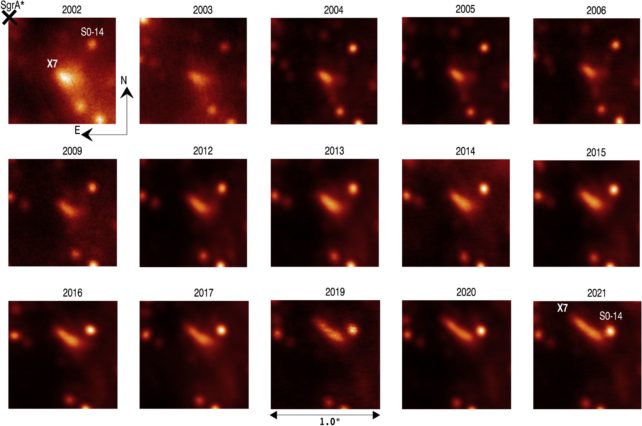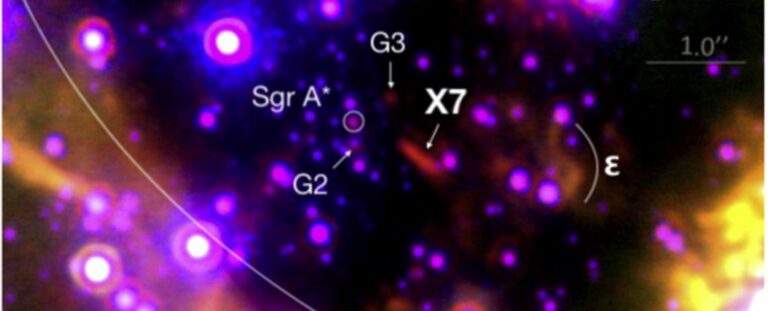The center of our galaxy is pulling an unidentified object into its black hole, posing a mystery.
Astronomers have been observing a strange object called X7 drifting near the supermassive black hole at the center of the Milky Way for decades, without knowing its origin. However, a team of scientists led by Anna Ciurlo, an astrophysicist at the University of California Los Angeles, has now analyzed 20 years’ worth of observations and discovered a significant transformation in X7’s shape. The object has stretched to nearly double its original length, indicating that it is likely made up of debris ejected from a collision between two stars that occurred relatively recently.

“No other object in this region has shown such an extreme evolution,” Ciurlo explains.
“It started off comet-shaped and people thought maybe it got that shape from stellar winds or jets of particles from the black hole. But as we followed it for 20 years we saw it becoming more elongated. Something must have put this cloud on its particular path with its particular orientation.”
If X7 is indeed a debris cloud, its discovery can shed light on the dynamics of the galactic center, including the frequency of stellar collisions and the impact of extreme gravity. The cloud, consisting of dust and gas, is expected to become increasingly spaghettified and eventually be pulled into the black hole Sagittarius A* (SgrA*) in just a few years. Researchers have determined that X7 has a mass approximately 50 times that of Earth, which is relatively small in space terms, equating to less than one-sixth of Jupiter’s mass.
Observations of the cloud’s position and velocity indicate that it is in an elliptical orbit around the galactic center with a period of about 170 years. However, simulations suggest that the cloud will not complete a single orbit, as it will be torn apart by the gravitational forces of Sgr A* during its closest approach, known as periastron, which is projected to occur in 2036. The resulting diffuse remnants will continue to circle the black hole until they eventually cross its event horizon, creating a spectacular display for any observers.
“It’s exciting to see significant changes of X7’s shape and dynamics in such great detail over a relatively short time scale as the gravitational forces of the supermassive black hole at the center of the Milky Way influences this object,” says astronomer and co-author Randy Campbell of Keck Observatory.
X7, an enigmatic object orbiting the galactic center, is similar to other mysterious blobs known as G objects in certain ways. G objects were discovered two decades ago and presented a conundrum: despite appearing like gas clouds, they acted like stars, elongating at periastron, but remaining intact and contracting back to a more compact form to continue orbiting. The hypothesis was that G objects were formed when two stars merged and produced a large cloud of material that remained in the gravitational field of the newly merged star, masking it from view. A recent study uncovered that one of these objects, G2, was a molecular cloud hiding three infant stars, although the identities of the others remain unknown. Although X7 shares similarities with the G objects, its evolution has been more pronounced in terms of its shape and velocity, elongating and accelerating as it approaches Sgr A*. While it may not be the same as G objects, X7 might have some connection to them.

“One possibility is that X7’s gas and dust were ejected at the moment when two stars merged,” Ciurlo says. “In this process, the merged star is hidden inside a shell of dust and gas, which might fit the description of the G objects. And the ejected gas perhaps produced X7-like objects.”
The absence of a central mass holding X7 together implies that its lifespan is expected to be much shorter compared to the G objects, which could be the reason why similar objects have not yet been discovered. It’s possible that the merged star that emitted X7 may still be present in the galactic center, following its own distinct orbit. The researchers have noticed a resemblance between the orbits of the G object G3 and X7’s orbit, and they suggest that G3 may be the parent object.
Nevertheless, other possibilities cannot be disregarded at this stage, such as X7 being a piece of debris that was stripped from a larger cloud. Additional observations are required to narrow down the possibilities.
Observing X7 as it approaches closer and closer towards its end could be interesting and fruitful in itself.
“Continued monitoring of X7 will allow us to closely witness these extreme changes,” the researchers write, “ending with the ultimate tidal dissipation of the remnants of this intriguing structure.”
The research has been published in The Astrophysical Journal.
Do not forget to share your opinion with us to provide you with the best posts !




0 Comments